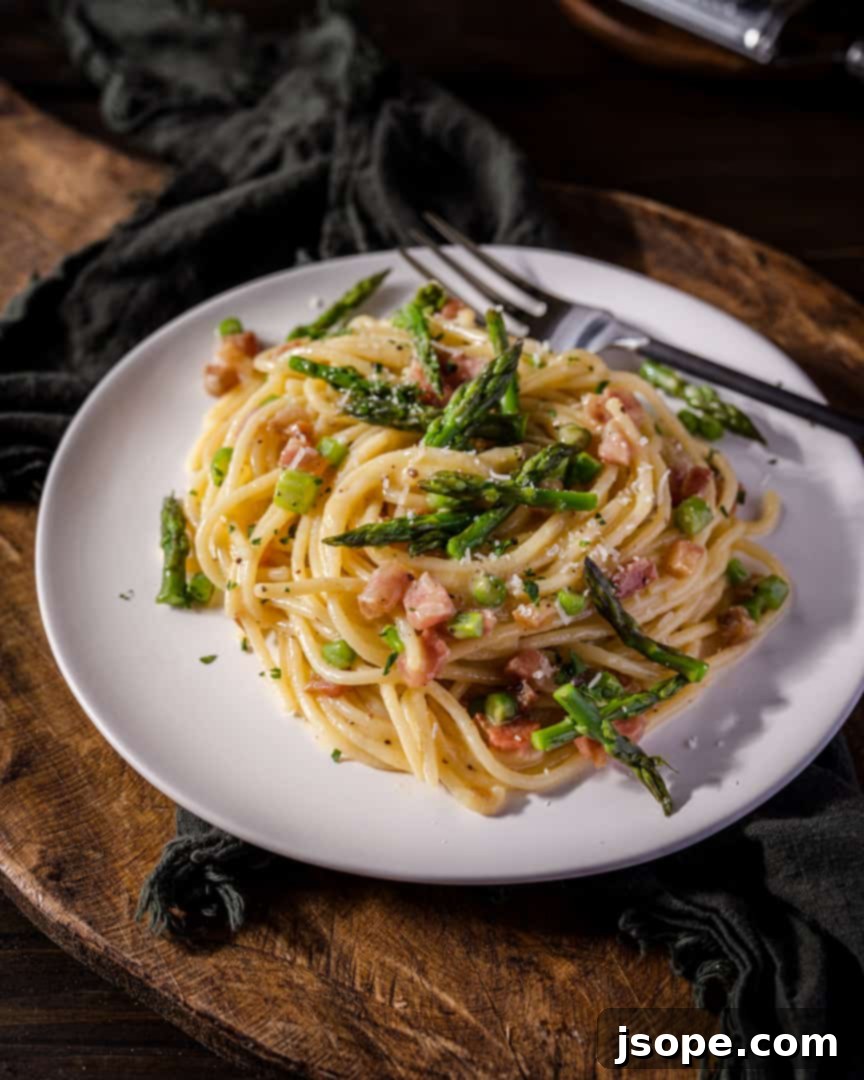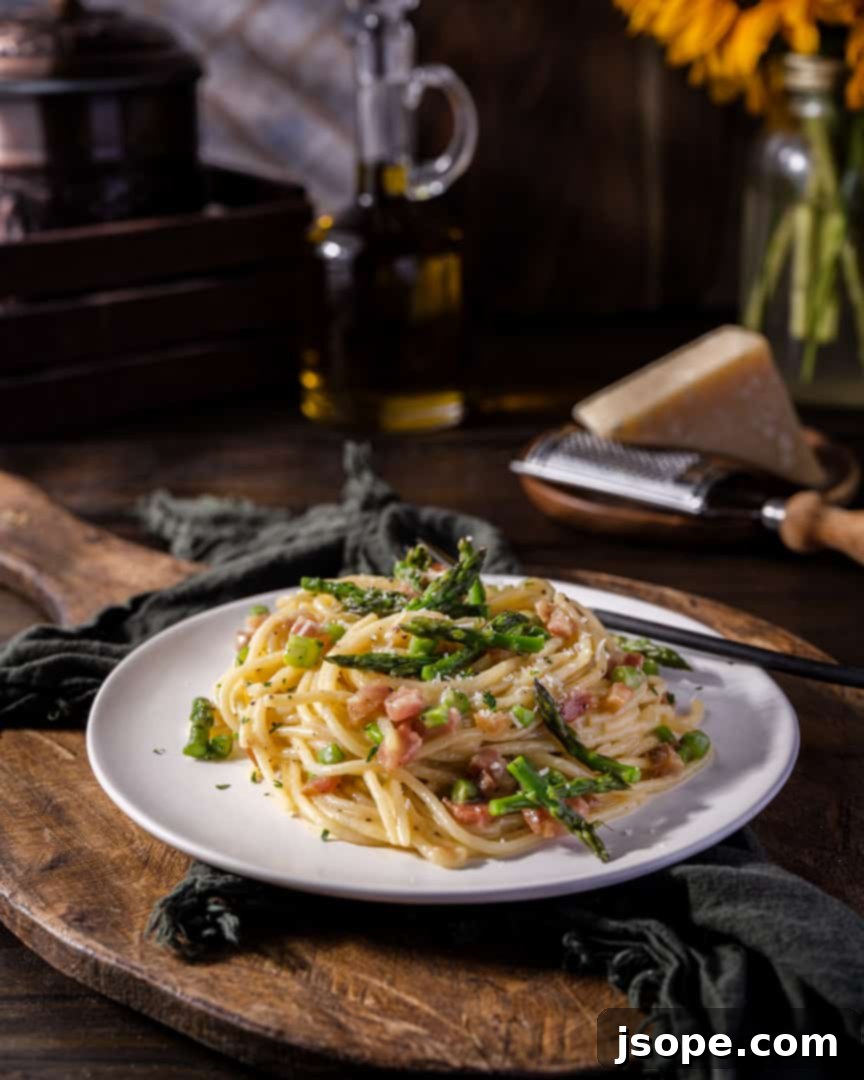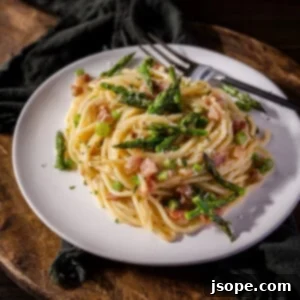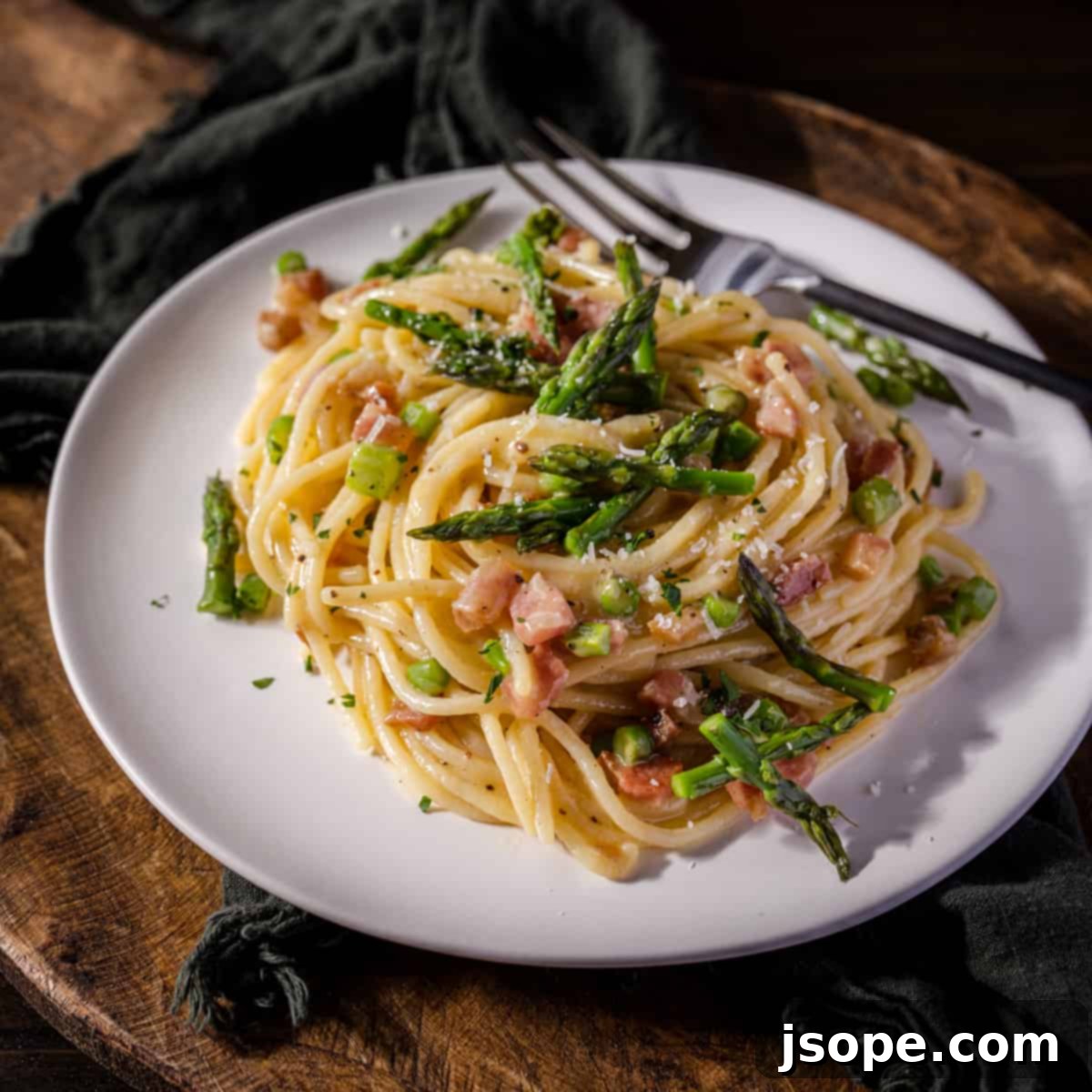Spaghetti Carbonara is a timeless and beloved pasta dish originating from the Lazio region of Italy. Renowned for its elegant simplicity and incredibly rich flavor, it has captured the hearts of food enthusiasts worldwide. This classic Roman creation typically features a luscious sauce crafted from egg yolks, Pecorino Romano cheese, cured pork (guanciale), and freshly ground black pepper, all brought together with the magic of starchy pasta water. While traditionally a hearty and comforting meal, our take on this iconic dish introduces a vibrant twist: fresh asparagus. This addition not only brightens the overall flavor profile but also introduces a delightful textural contrast, making it perfect for a spring or early summer dining experience without compromising its authentic Italian soul.

The True Essence of Carbonara: Simplicity and Quality
At its heart, authentic Carbonara embodies the Italian culinary philosophy of using a few high-quality ingredients to create something extraordinary. Many mistakenly believe this dish contains cream, but the hallmark of a true Carbonara lies in its silky, emulsified sauce, achieved solely through the perfect synergy of egg yolks, hard cheese, rendered pork fat, and hot pasta water. It’s a delicate dance of temperatures and textures that transforms humble components into a creamy, deeply satisfying masterpiece. Our recipe respects this tradition while artfully weaving in the freshness of asparagus to elevate the experience.
Unveiling the Star Ingredients: What Makes This Carbonara Shine?
While the ingredient list for Carbonara is remarkably short, the choice and quality of each component are paramount. They are not merely ingredients; they are the pillars that uphold the dish’s distinctive character and flavor. Here’s a closer look at what we recommend for an unparalleled experience, including our special addition:
Guanciale: The Unmistakable Flavor Base
For an authentic Spaghetti Carbonara, guanciale is non-negotiable. This cured meat, sourced from the pig’s jowl, possesses a unique fatty composition and a deep, complex flavor profile that sets it apart from other pork products. Unlike bacon, guanciale is not smoked, allowing its rich, savory notes to shine without overpowering the delicate balance of the dish. When rendered slowly, it releases a flavorful fat that becomes the foundation of the sauce, imparting an unparalleled depth and umami. Its distinct texture—crispy on the outside, tender within—adds a crucial element to every bite. While finding guanciale might require a visit to a specialty Italian market or a gourmet butcher, the effort is truly rewarded. Its traditional role in Carbonara is integral, contributing significantly to the dish’s authenticity and extraordinary taste. If guanciale is absolutely unavailable, high-quality pancetta is the best alternative, offering a similar unsmoked, cured pork flavor. Bacon, with its strong smoky and salty characteristics, should only be considered as a last resort, as it can significantly alter the traditional flavor profile.
Pecorino Romano Cheese: The Tangy Heart
When it comes to the cheese for an authentic Carbonara, there’s very little room for debate: it must be Pecorino Romano. This hard, salty cheese, made from sheep’s milk, hails from the same region as Carbonara itself and is celebrated for its sharp, tangy, and deeply savory notes. It provides the essential piquant kick that balances the richness of the egg and guanciale. For the creamiest sauce, we advise seeking out a less-aged Pecorino Romano if possible, as it will melt more smoothly and integrate beautifully into the emulsion. While Parmigiano Reggiano is a fantastic cheese in its own right and can be used to create a delicious pasta dish, it will result in a different flavor and a departure from true Carbonara authenticity. Its nutty, less assertive profile simply doesn’t deliver the same punch. However, culinary exploration is always encouraged, so if Parmigiano is your preference, feel free to use it – just be aware the taste will differ. Regardless of your choice, investing in a high-quality, freshly grated cheese is non-negotiable for superior results.
Fresh Egg Yolks: The Velvet Emulsion
The magic of Carbonara’s signature creamy sauce comes predominantly from fresh egg yolks. While some variations might include a whole egg, focusing primarily on yolks ensures a richer, more luxurious texture and a deeper golden hue. These yolks, when combined with the hot pasta, melted cheese, and rendered guanciale fat, create a silky, emulsified sauce that coats every strand of spaghetti without ever feeling heavy. The key is to work quickly and with the right temperatures to prevent the eggs from scrambling, transforming them instead into a velvety coating. Using farm-fresh, high-quality eggs will enhance the flavor and color of your Carbonara significantly.
Freshly Ground Black Pepper: The Aromatic Finish
Often overlooked, freshly ground black pepper is a crucial ingredient in Carbonara, adding an aromatic complexity and a subtle fiery kick that cuts through the richness of the dish. The term “Cacio e Pepe” (cheese and pepper) highlights its importance in Roman pasta traditions. Using pre-ground pepper simply won’t suffice; the fresh aroma and biting flavor of cracked peppercorns are essential for the authentic experience. We recommend grinding it generously just before adding it to the sauce, ensuring its vibrant essential oils are at their peak.
Asparagus: Our Vibrant Spring Twist
To infuse the classic Spaghetti Carbonara with a touch of seasonal freshness and a beautiful pop of color, we’ve incorporated tender asparagus. This addition provides a delicate, earthy sweetness and a slight crunch that beautifully complements the rich, savory flavors of the guanciale and Pecorino. The asparagus brightens the entire dish, making it feel lighter and perfect for warmer months, all without altering the beloved overall flavor profile of traditional Carbonara. It’s a subtle yet impactful twist that makes this recipe truly special.

Mastering the Technique for a Perfect Carbonara Sauce
The secret to a truly spectacular Carbonara lies not just in its ingredients but in the precise technique used to combine them. Achieving that perfectly creamy, non-scrambled sauce is a skill worth honing, and it largely depends on how you cook your spaghetti and bring everything together.
The Art of Cooking Spaghetti
Cooking your pasta correctly is a fundamental step for any great Italian dish, but it’s especially critical for Carbonara. We’ve discovered a helpful trick: use less water than usual to cook your spaghetti. While it might seem counterintuitive, this ensures the pasta water becomes exceptionally starchy. This starchy water is a golden elixir for Carbonara, playing a vital role in creating that luscious, emulsified sauce. The starches released from the pasta act as a binding agent, helping the egg and cheese mixture cling beautifully to every strand.
Furthermore, when salting your pasta water, be mindful of the other ingredients. We recommend using a little less salt than you might typically use. This is because both guanciale and Pecorino Romano cheese are inherently quite salty. Adjusting the salt in the pasta water prevents the final dish from becoming overly seasoned, allowing the complex flavors of each component to truly shine through without being overwhelmed by saltiness. Cook the spaghetti until it’s perfectly al dente, meaning it still has a slight bite to it. This texture is essential, as the pasta will continue to cook slightly when tossed with the hot sauce.
Creating the Silky Emulsion
The moment of truth in Carbonara is when you combine the ingredients to form the sauce. It’s crucial to work quickly and efficiently. The residual heat from the freshly cooked spaghetti is what gently cooks the egg yolks, transforming them into a thick, creamy sauce rather than scrambled eggs. As you transfer the hot pasta directly from the pot to the bowl containing the guanciale, egg yolks, cheese, and pepper, stir vigorously. The heat from the pasta, combined with the rendered fat and starchy pasta water, will create that magical emulsion. If the sauce seems too thick or needs more creaminess, gradually add small amounts of the reserved starchy pasta water, stirring continuously until you reach your desired consistency. This process should happen swiftly to ensure the sauce remains smooth and glossy.
Serving and Enjoying Your Carbonara with Asparagus
Spaghetti Carbonara with Asparagus is best enjoyed immediately. The vibrant colors and intoxicating aromas are at their peak right after preparation. Serve it in warm bowls, perhaps with an extra dusting of Pecorino Romano and a final grind of black pepper, to truly savor every bite. This dish, while rich, finds a beautiful balance with the fresh crunch of asparagus, making it incredibly satisfying yet surprisingly light. It’s a testament to how simple ingredients, handled with care and respect for tradition, can yield an unforgettable culinary experience.
Delight in Every Bite!
We genuinely hope you enjoy this exquisite recipe for Spaghetti Carbonara with Asparagus. It’s a dish that celebrates both classic Italian flavors and the freshness of seasonal produce. If you try it in your kitchen, we would absolutely love to hear about your experience! Please consider leaving us a comment below to share your thoughts, or tag us on Instagram @cooking_with_wine! Your feedback and shared culinary adventures truly inspire us.

Looking for more delightful pasta recipes or Italian-inspired dishes? Explore these other favorites from our collection:
- Spring Spaghetti Aglio Olio e Peperoncino with Blistered Tomatoes
- Summer Pasta (Pasta D’Estate)
- Roasted Zucchini and Tomato Pasta
- Our Current Favorite Pasta Dishes for Spring and Summer
📖 Recipe

Spaghetti Carbonara with Asparagus
Pin Recipe
Ingredients
Ingredients
- 8 oz asparagus
- 1 teaspoon olive oil
- 5 ounces guanciale – small dice
- 4 egg yolks
- ½ cup grated Pecorino Romano* cheese
- 1 -2 teaspoon fresh ground black pepper
- 8 oz Spaghetti (for homemade, use 1 recipe of our Multipurpose Pasta Dough cut into spaghetti)
Instructions
- First, prepare the asparagus. Cut the tips off and reserve. The remainder of the asparagus spear should be cut into thin rounds (¼ inch or even less). Fill a medium saucepot with water and bring to a boil. Have a bowl of ice water ready to shock the asparagus. When the water boils, add a tablespoon of salt, and stir. Add the asparagus tips for about 10 seconds then add the rest of the asparagus pieces for another 30 seconds. Remove or strain through a colander all the asparagus and immediately put them into the ice bath. Once they have cooled down, remove the asparagus and dry on paper towels. Set aside.
- In a skillet over medium heat, add the olive oil and cook the guanciale until it becomes somewhat crispy (5-10 minutes). Remove with a slotted spoon to paper towels to drain excess fat.
- While your guanciale browns, fill a large pot with water and bring to a boil. Use less water than you normally would to make a pound of pasta (about 3 quarts). Salt the water with about 2 tablespoon of kosher salt.
- In a large mixing bowl, add the crisped guanciale, egg yolks, cheese and pepper and mix thoroughly. Add the asparagus to this mixture. Set aside.
- Add the spaghetti to the pot and cook until al-dente. Move the spaghetti directly from the pot to the large mixing bowl and stir for about 20 seconds. If you need more creaminess and sauce, add a little of the pasta water to the bowl. Serve immediately with extra grated cheese on top.
Notes
Nutrition
Support Our Passion for Delicious Recipes
We pour our hearts into developing and sharing delicious, accessible recipes here on Cooking With Wine, all offered to you absolutely free. If you appreciate the value we bring to your kitchen and wish to support our continuous efforts, any contribution you feel comfortable with would be deeply cherished. Your generosity helps us keep creating and sharing the culinary content you love.
There is absolutely no obligation to contribute, as we are committed to providing you with fantastic recipes regardless. However, every contribution, no matter the size, helps sustain our work and is immensely appreciated!
Thank you for being an invaluable part of our cooking community. You are the inspiration behind everything we do!
